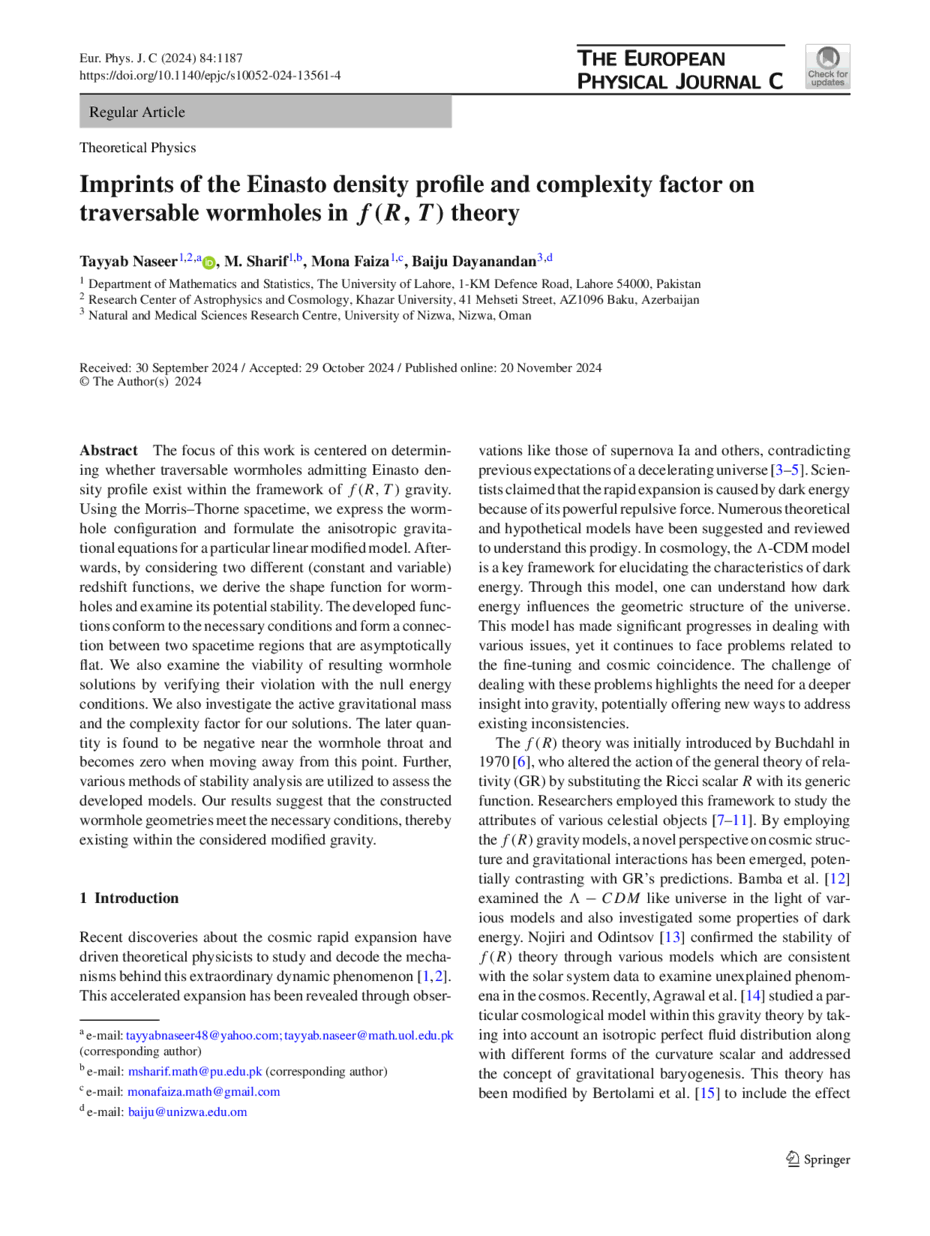https://doi.org/10.1140/epjc/s10052-024-13561-4
Regular Article
Imprints of the Einasto density profile and complexity factor on traversable wormholes in f(R, T) theory
1
Department of Mathematics and Statistics, The University of Lahore, 1-KM Defence Road, 54000, Lahore, Pakistan
2
Research Center of Astrophysics and Cosmology, Khazar University, 41 Mehseti Street, AZ1096, Baku, Azerbaijan
3
Natural and Medical Sciences Research Centre, University of Nizwa, Nizwa, Oman
a tayyabnaseer48@yahoo.com, tayyab.naseer@math.uol.edu.pk
b
msharif.math@pu.edu.pk
Received:
30
September
2024
Accepted:
29
October
2024
Published online:
20
November
2024
The focus of this work is centered on determining whether traversable wormholes admitting Einasto density profile exist within the framework of f(R, T) gravity. Using the Morris–Thorne spacetime, we express the wormhole configuration and formulate the anisotropic gravitational equations for a particular linear modified model. Afterwards, by considering two different (constant and variable) redshift functions, we derive the shape function for wormholes and examine its potential stability. The developed functions conform to the necessary conditions and form a connection between two spacetime regions that are asymptotically flat. We also examine the viability of resulting wormhole solutions by verifying their violation with the null energy conditions. We also investigate the active gravitational mass and the complexity factor for our solutions. The later quantity is found to be negative near the wormhole throat and becomes zero when moving away from this point. Further, various methods of stability analysis are utilized to assess the developed models. Our results suggest that the constructed wormhole geometries meet the necessary conditions, thereby existing within the considered modified gravity.
© The Author(s) 2024
 Open Access This article is licensed under a Creative Commons Attribution 4.0 International License, which permits use, sharing, adaptation, distribution and reproduction in any medium or format, as long as you give appropriate credit to the original author(s) and the source, provide a link to the Creative Commons licence, and indicate if changes were made. The images or other third party material in this article are included in the article’s Creative Commons licence, unless indicated otherwise in a credit line to the material. If material is not included in the article’s Creative Commons licence and your intended use is not permitted by statutory regulation or exceeds the permitted use, you will need to obtain permission directly from the copyright holder. To view a copy of this licence, visit http://creativecommons.org/licenses/by/4.0/.
Open Access This article is licensed under a Creative Commons Attribution 4.0 International License, which permits use, sharing, adaptation, distribution and reproduction in any medium or format, as long as you give appropriate credit to the original author(s) and the source, provide a link to the Creative Commons licence, and indicate if changes were made. The images or other third party material in this article are included in the article’s Creative Commons licence, unless indicated otherwise in a credit line to the material. If material is not included in the article’s Creative Commons licence and your intended use is not permitted by statutory regulation or exceeds the permitted use, you will need to obtain permission directly from the copyright holder. To view a copy of this licence, visit http://creativecommons.org/licenses/by/4.0/.
Funded by SCOAP3.






